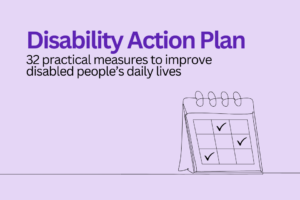
In recent years, there has been a growing recognition of the need to address the unique challenges faced by deaf individuals in accessing government services and resources. The government has announced the ambition for the UK to be the most accessible place in the work.
The Disability Action Plan, through its various initiatives and commitments, aims to improve the lives of all disabled individuals, including those who are deaf or have a hearing loss. Let’s delve into some of the key outcomes of the Disability Action Plan specifically related to the deaf community.
1. Improved and Accessible Communications:
One of the cornerstone commitments of the Disability Action Plan is to enhance communications about government services and resources, making them more accessible to a wide range of disabled people, including deaf people. For instance, Number 10 Downing Street has made new commitments to increase the use of British Sign Language (BSL) in government communications. By ensuring that vital information is communicated in BSL, the government is taking a significant step towards inclusivity for the deaf community.
This has no doubt been influenced by the #WhereIsTheInterpreter campaign that started at the peak of the Pandemic in response to the Government not providing BSL Interpreting for its public broadcasts.
2. Equality of Opportunity:
The Disability Action Plan also aims to promote equality of opportunity for disabled people. For deaf individuals, this means addressing barriers that prevent full participation in various aspects of life, including politics.
By supporting disabled people who aspire to hold public office and ensuring that workplaces are accessible, through the Disability Action Plan, the government is striving to create a more inclusive society where deaf individuals have an equal opportunity to contribute and thrive.
3. Inclusion in Emergency and Resilience Planning:
Deaf individuals often face unique challenges during emergencies or crises due to communication barriers. Recognising this, the Disability Action Plan seeks to include disabled people’s needs in emergency and resilience planning.
By ensuring that emergency plans take into account the needs of deaf people, such as providing sign language interpretation, the government is working towards building a more resilient and inclusive society.
4. Accessible Information Hubs:
Another significant initiative under the Disability Action Plan is the development of accessible online information hubs for families with disabled members. While not explicitly mentioning deaf people, these hubs have an indirect benefit by providing information in accessible formats, including captioning and access to the information in BSL.
5. Promotion of BSL and Accessibility Standards:
The commitment to increase and report on the use of BSL in government communications, as well as the efforts of the Government Communication Service to promote accessible communications, highlights the government’s dedication to improving accessibility standards for the deaf community. By providing in-situ BSL interpretation for major press conferences and briefings, Number 10 Downing Street sets a precedent for other government departments to follow suit, ensuring that deaf people are not left behind in crucial communications.
In conclusion, the Disability Action Plan represents a significant step towards creating a more inclusive society, so deaf people can have equal access to opportunities and resources. By prioritising accessible communications, promoting equality, and considering the unique needs of the deaf community in various aspects of policy making, the government is laying the groundwork for a more equitable future for all.
Click here to take a look at the full Disability Action Plan.

